Back in the spring, the numbers for Democrats weren’t looking very healthy. The strong support that Joe Biden had enjoyed from young voters in 2020 just wasn’t showing up, and that was dragging his overall numbers down. Some of that was because pollsters are notoriously unable to find enough young people to build a broad, representative sample. But even in surveys aimed only at younger voters, Biden had a long way to go.
For example, the spring youth survey of some 2000 young Americans by the Harvard Institute of Politics, considered the gold standard for assessing the political attitudes of young voters, contained some truly worrisome numbers for Biden on voter preference and enthusiasm. I remember thinking at the time, “Well, at least we still have enough time to build on these.”
But to be honest, I did need to close my eyes and tell myself repeatedly, “By the fall, the base will come back, the base will come back, the base will come back….”
Kamala Harris’s entry into the race in July and her official nomination in August ignited excitement across that base, and since then I have been dying to know: What would the data tell us now about the missing youth vote?
I now have my answer. The fall youth survey by Harvard just came out. And, drumroll… It’s got some numbers that are great for Harris but have got to worry the Trump campaign.
Today I’ll walk through those figures, comparing not only current support for Harris versus Trump but also how the numbers have shifted since the spring and how they stack up historically. Then I want to throw a somewhat controversial position out there: Does the fall youth survey suggest that the national polls are undercounting Harris’s true support, possibly by a lot?
Reasons to cheer
Here’s the top line number to take away: According to the fall survey, Harris leads Trump among likely voters under 30 by a devastating 31 points, 61 to 30. Her lead among registered voters is 23 percent, at 52 to 29. Remember, likely voters is where the game is at.
That number is way up from the historically low 13 point lead Biden had in a multi-candidate field back in the spring, when Biden led Trump only by 43-30. That anemic 13 point lead gave me agita back then because Biden had done so much better back in 2020, when he was 24 points up with this same set of voters.
Notably, Trump’s numbers are unchanged from the spring survey, meaning this movement toward Harris represents consolidation by her campaign.
But okay, will these voters really turn out to vote? Aren’t young people notoriously bad at giving a damn? Not since 2018 they aren’t. In fact, ever since Trump’s election, young people have been turning out in historically high numbers to register their protests. And this year looks to continue that trend.
As The Hill reported in assessing the fall youth survey, Harris has now closed the enthusiasm gap, with 80 percent of Democrats under 30 now saying they are enthusiastic about Harris, compared to 75 percent of Republicans for Trump. Notably, enthusiasm for Trump has remained consistent, but Harris’s numbers have shot up relative to Biden’s spring numbers, when only half of Democratic respondents registered enthusiasm.
It’s all fine and good to claim enthusiasm, but will it translate into actual votes? On this question, nearly three out of four Democratic respondents now say they “definitely” plan on voting, compared to three out of five Republicans.
That is around a 14 point gap in definite voting intention between young Democrats and Republicans.
Digging deeper
When an important survey like this comes out, I’m eager to verify that many of the other numbers check out, too. One of the most salient features of this election is that, against Trump, Harris has opened a formidable gap with women voters. That’s not surprising given that abortion rights are top of mind for many women voters; Trump is an adjudicated rapist; and Vance is a sneering, gross misogynist.
The Harvard youth survey confirmed this, too. Young women now favor Harris 70 to 23 percent, or 47 points. That is remarkably on par with the 47 point gap we saw with young women in the 2020 survey, when Biden led Trump with this group 68 to 21. And it beats Hillary Clinton’s +37 number in 2016 by a solid 10 points.
Unsurprisingly, Harris doesn’t fare as well with young men as Biden did in 2020. Harris still leads this group 53 to 36 (17 points), but Biden led it by a wider margin of 57 to 29 (28 points). This confirms that Trump has made inroads with young males by investing in streaming, video game chatrooms and podcasts, where such voters typically can be found. It remains to be seen, however, whether young men, especially young men of color, will actually turn out for Trump or remain politically apathetic.
The favorability numbers are also good for Harris and Walz in the fall youth survey. Harris has a +5 net favorability (47 to 42) and Walz has a whopping +14 (36 to 22). This compares to a -19 for Biden, a -30 for Trump, and a -28 for Vance.
Further, on nearly every important character trait, including Trump’s claim of strength, Harris beats Trump handily in this group.
Harris also trounces Trump on tackling the issues important to young voters, even beating him among both registered and likely voters on his signature issues of the economy, national security, and immigration. On the controversial question of the Israel-Hamas war, she also tops Trump with both registered and likely voters.
Are the other polls missing this group?
Many national polls continue to report a far smaller gap between the candidates when surveying younger voters. As Tom Bonier of TargetSmart noted, the much-touted CNN poll out this Tuesday showed Harris with just a one point national lead. That included, however, a narrow lead of 12 points among young voters.
Remember, the Harvard youth survey poll showed Harris with a far bigger lead of 31 points—one that was even larger than Biden had in 2020—with the same voters.
Jacob Rubashkin, the Deputy Editor of Inside Elections, made the same observation, tactfully calling it a “fractured polling environment” when the CNN poll “shows voters 18-34 breaking for Harris 52-40%” while “The Harvard Youth Poll out today has Harris leading voters 18-30 by 31 points, 61-30. Slightly different populations but very different results.”
Further, Bonier pointed out that the Harvard youth survey had Harris up 17 points among independents, which is five points wider than CNN’s poll showed for all young voters.
So what gives?
Bonier was probably being polite when he wrote, “I can't tell you exactly why these discrepancies exist, but I have a feeling that the national polls are having a hard time properly sampling unaffiliated voters among these groups, often resulting in a too conservative sample.”
Let me break that down a bit. If the sample of young voters is itself too conservative, once it gets further “weighted” to match the “model electorate,” that mistake can easily get amplified. I believe that is what is going on here.
Here’s the bottom line: The Harvard youth survey has consistently come far closer than the generalized national polls to what the actual vote counts are come Election Day. This is unsurprising given that the Harvard poll is a broad sample survey, and it has more experience in investing in and being able to actually reach young voters.
It should surprise no one that, according to the Harvard study, Harris’s numbers among young voters now exceed Biden’s in 2020. Recent actual vote data backs this up. In 2022, Gen Z voted for the Democratic candidate around 65 percent of the time, up from 62 percent in 2020 according to data modeling by Catalist. Without the “enthusiasm blues” surrounding Biden’s age to weigh things down, there is no reason today to think Harris couldn’t put up similar numbers today. The Harvard youth survey in fact now points to something very close to those numbers, with still six weeks to go.
One of the best predictors of voter behavior is how they actually voted in the recent past, with some reshuffling around the edges. If Harris is indeed winning the youth vote by 31 percent and not 12, as CNN’s poll had suggested, then this aligns with recent actual voting history. By extension, that 12 percent is low, and her national lead is much bigger than reported. It’s entirely possible, and to my mind more likely, that some of the big polling outfits just can’t seem to get the youth vote right.
In 2022, that youth vote, combined with disaffected Republican voters who refused to cast ballots for extremists, was key to keeping the battlegrounds in the blue column up and down the ballot. It’s the reason we won statewide races in every important swing state. And, dare I say it, the broader data says that we are heading for the same result come Election Day.
The Harvard youth survey shows that the Harris/Walz campaign has now consolidated the youth vote as we had hoped and expected, completing a critical missing part of the puzzle. Now it’s up to all of us to power through to victory with that crucial part of our coalition finally in place.




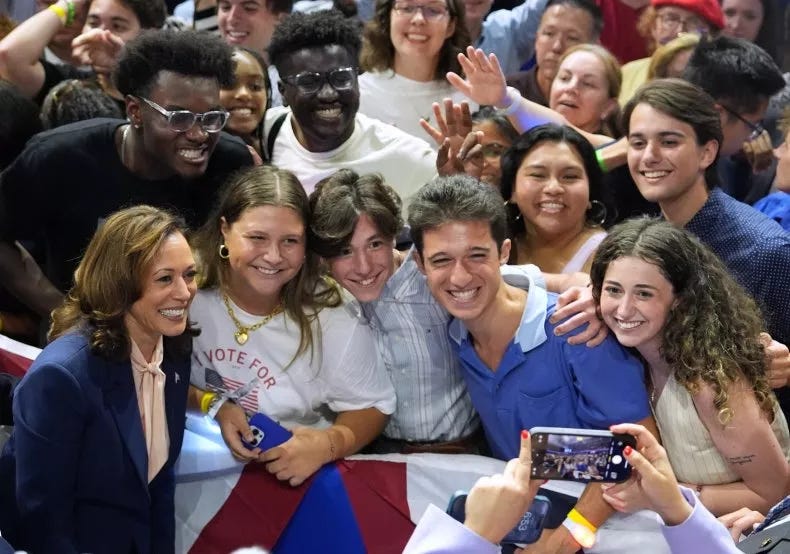
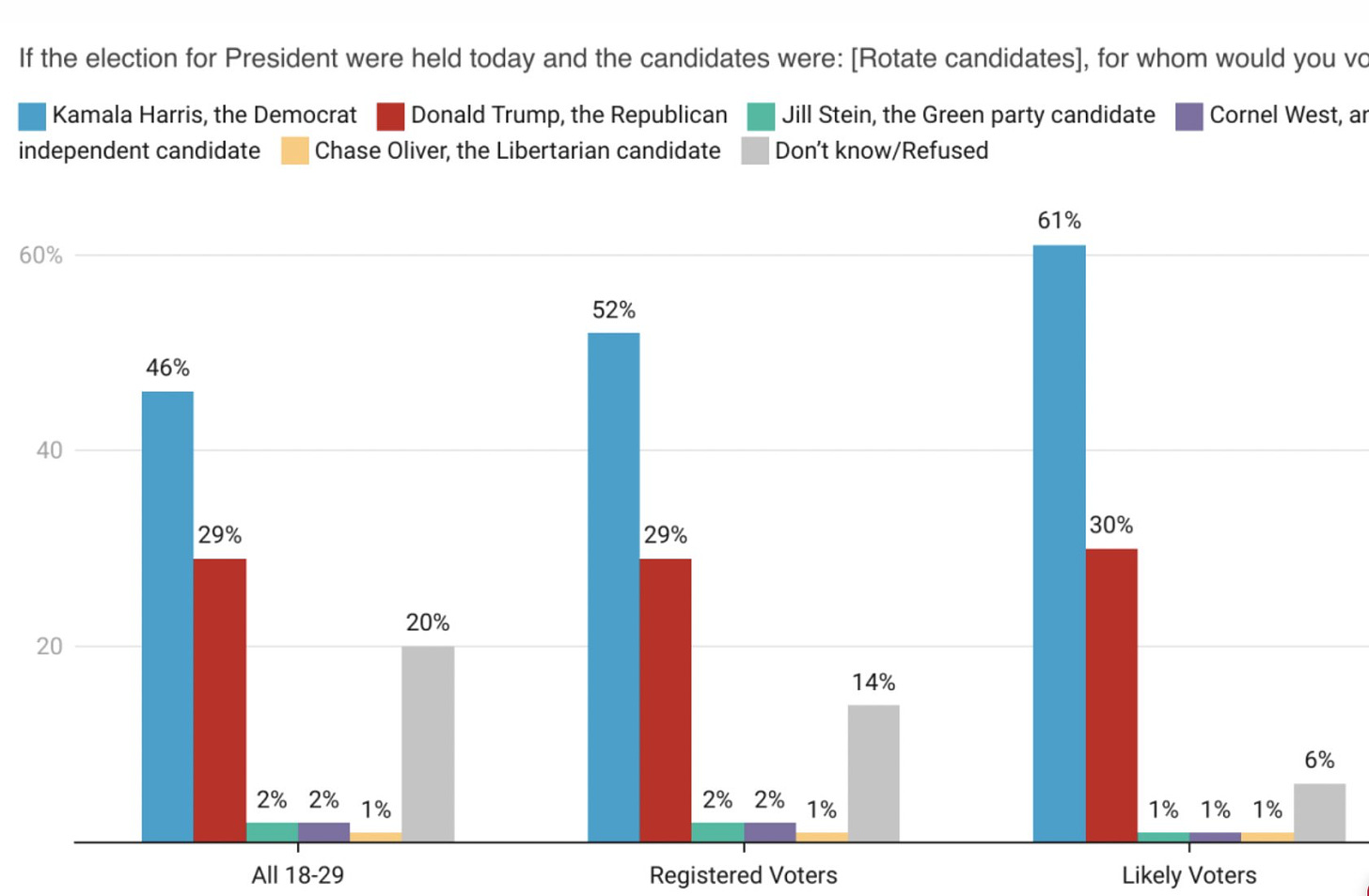
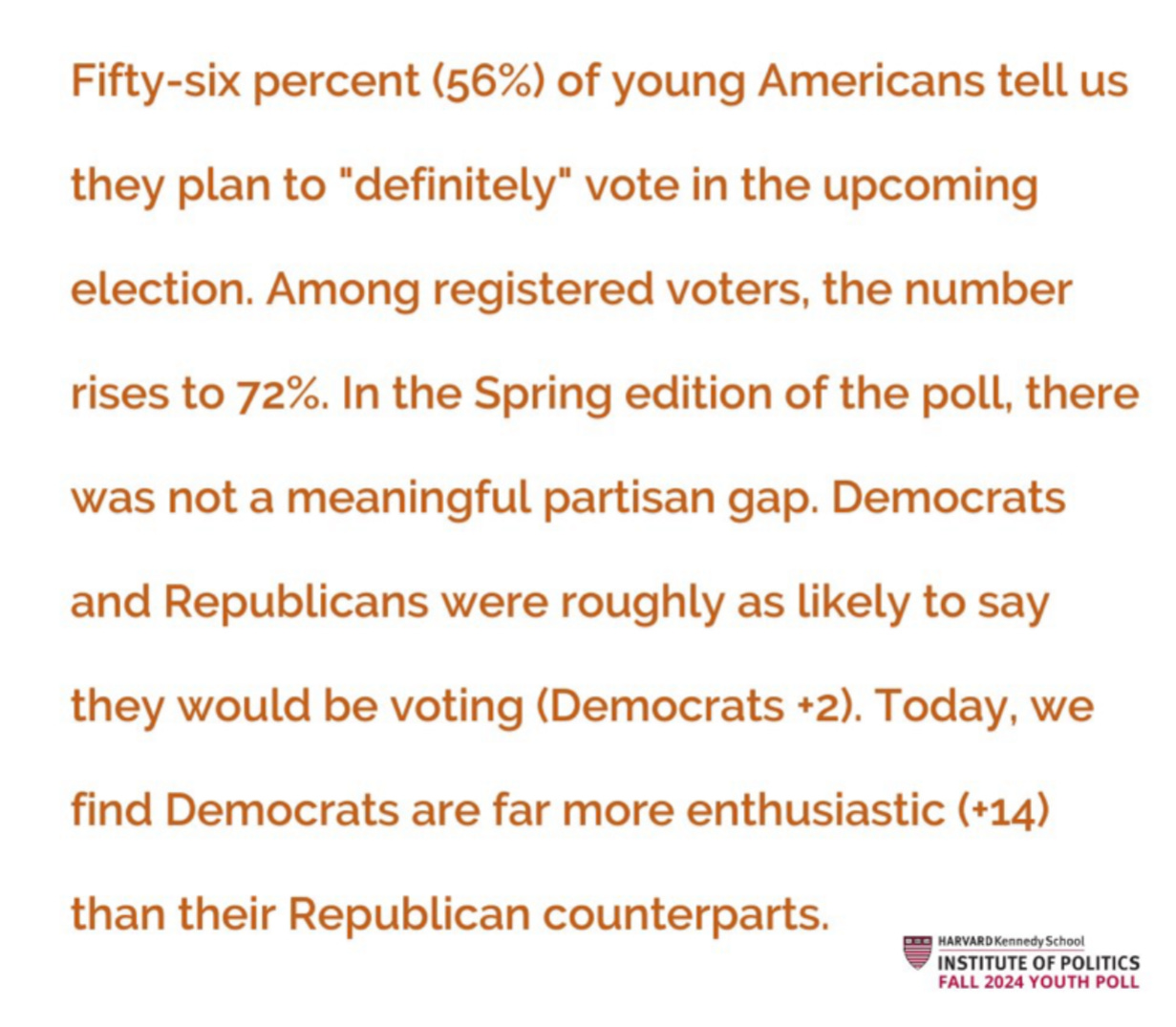
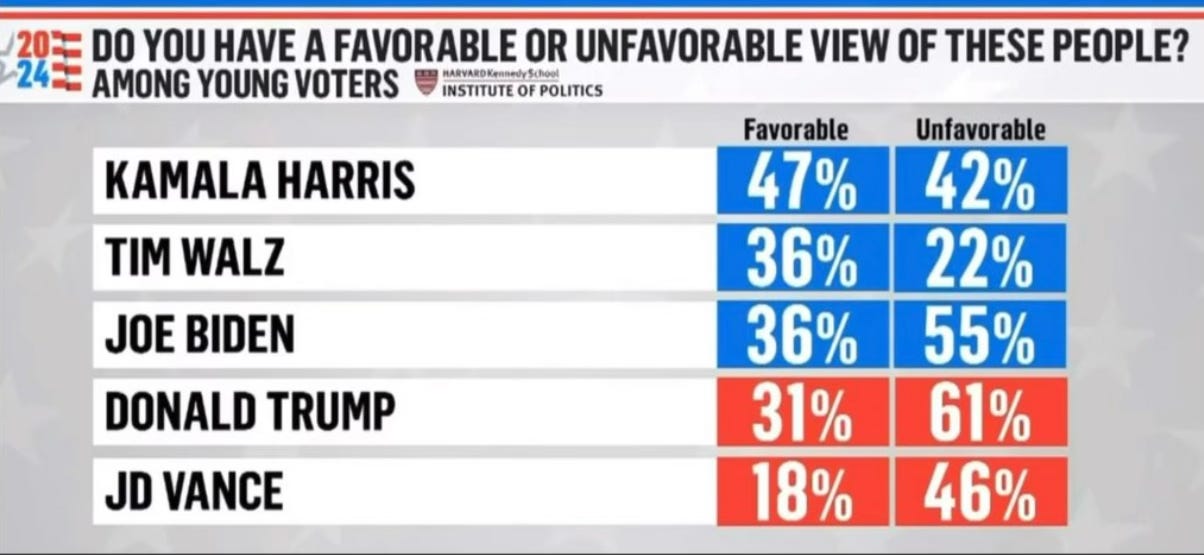
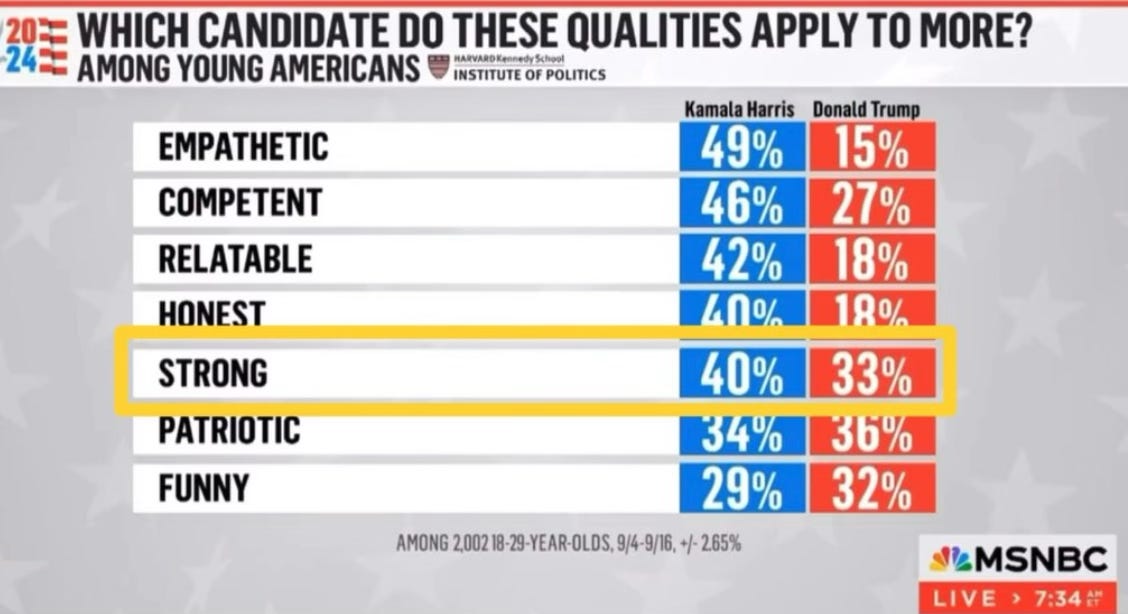
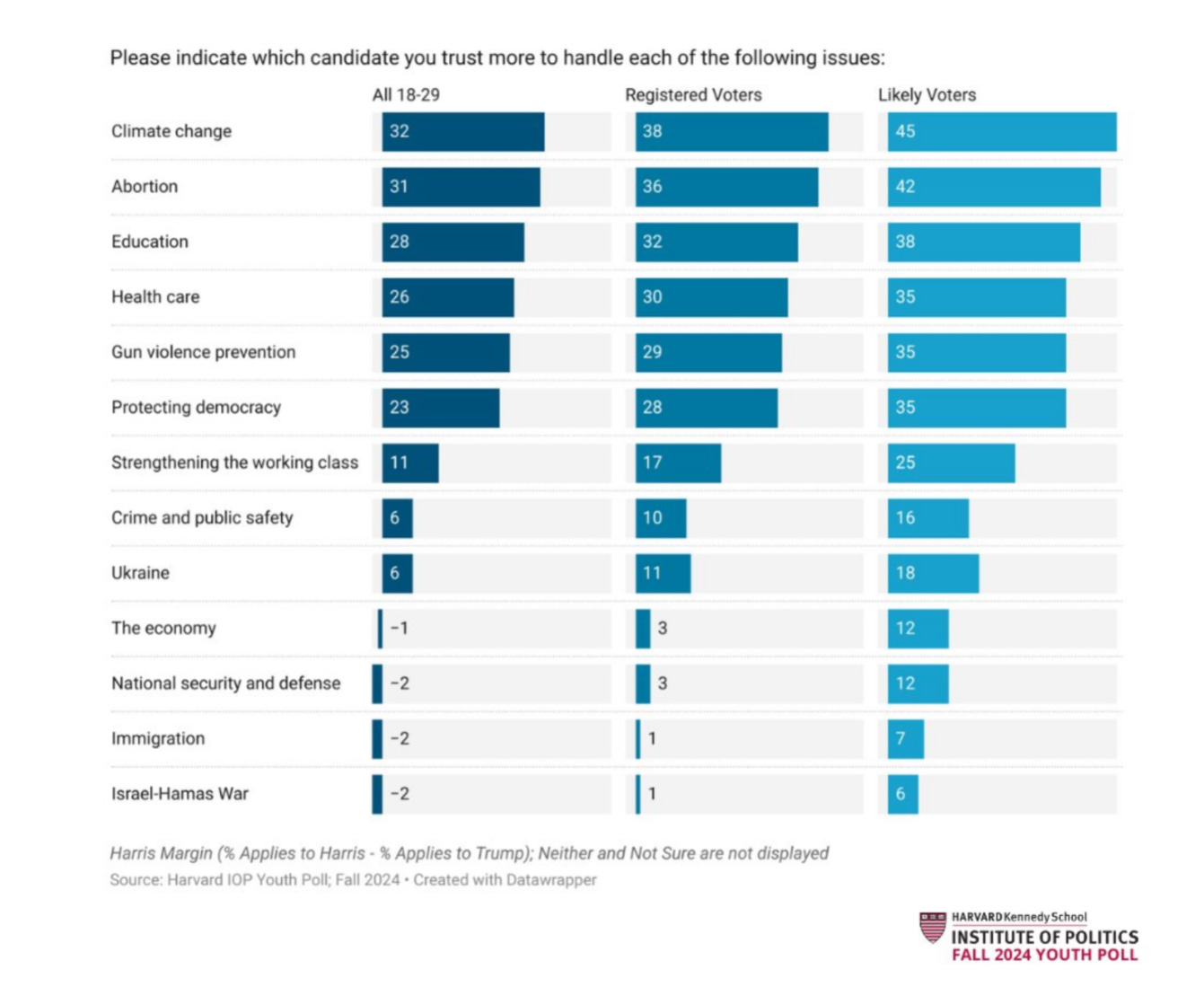
I have suspected (and hoped) that the mainstream polls are not capturing the youth perspective. Great post! Thank you
Exciting news! Young people get it. It’s their future on the line and they will speak!